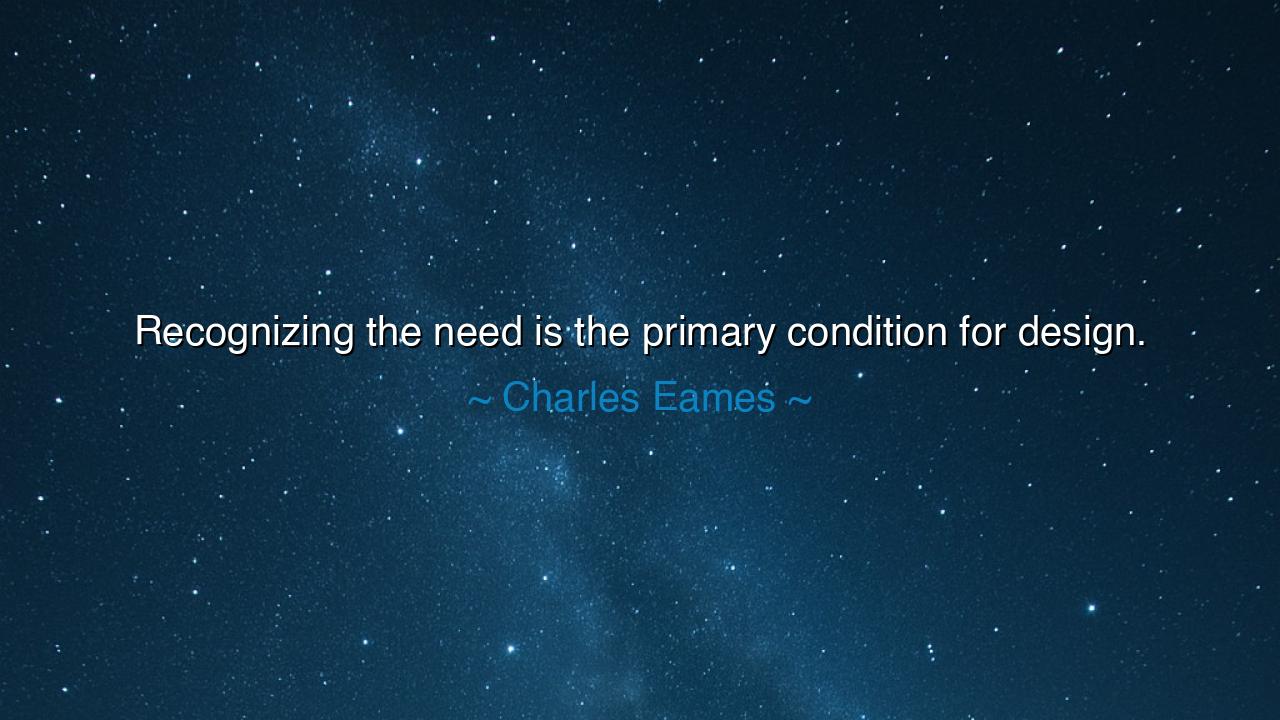
Recognizing the need is the primary condition for design.






“Recognizing the need is the primary condition for design.” — Charles Eames
Thus spoke Charles Eames, the great craftsman of simplicity and purpose, whose designs graced the modern world with elegance and human understanding. In these few immortal words — “Recognizing the need is the primary condition for design” — he unveiled the eternal law that governs all creation: that true design begins not with beauty, nor ambition, nor invention, but with understanding. To recognize a need is to open one’s eyes to the human condition — to perceive where life stumbles, where comfort falters, where meaning can be restored. Before the hand may create, the heart must first see.
The origin of this wisdom lies in the very spirit of Eames’s work. Together with his wife and partner, Ray Eames, he transformed the landscape of twentieth-century design by crafting objects that served both utility and soul. Their furniture — graceful yet strong, simple yet profound — was born not from luxury, but from necessity. After World War II, when materials were scarce and homes were humble, they asked not, “What can we make?” but “What is needed?” From that question came the Eames Chair, made of molded plywood — a union of form and function that became a symbol of democratic design. In every curve of its seat lies the truth Eames spoke: to design well is first to serve well.
Recognizing the need is the art of listening — to people, to place, to time. It requires humility, for the designer must quiet the ego that seeks to impress and instead attend to the whispers of reality. It is the same humility that guided the builders of ancient civilizations. The Roman aqueduct, arching across the valleys of time, was not conceived as art, but as necessity — a response to thirst, to the need for water and life. Yet in answering that need with intelligence and grace, it became a masterpiece. So too did the architects of the Great Wall of China, who built not for glory, but for protection; and the weavers of the Andean textiles, who shaped beauty while meeting the needs of warmth and tradition. All great design, in every age, begins with compassion.
Eames’s words remind us that need is the mother of meaning, and that every true creation must be born of empathy. The designer is not a god shaping worlds of his own, but a servant of humanity, translating struggle into solution. When the Wright brothers built their first plane, they were not chasing beauty but the human dream of flight — a need as old as the sky. When Florence Nightingale redesigned hospitals, she saw not architecture, but suffering, and turned her vision toward healing. Their greatness lay not in imagination alone, but in perception — in their ability to see what others overlooked.
In our age, when technology dazzles and form often overtakes function, Eames’s wisdom stands as a moral compass. To recognize the need is to resist the emptiness of excess. It is to remember that the purpose of design — whether in art, in industry, or in life — is not to decorate existence, but to improve it. The chair that supports the weary worker, the bridge that shortens the journey, the app that connects a lonely heart — these are the silent triumphs of need recognized and answered. Without this awareness, design becomes vanity; with it, design becomes service.
The lesson is this: to create meaningfully, you must first learn to see meaningfully. Do not rush to make; first, understand. Observe the world — its struggles, its inefficiencies, its quiet pleas for betterment — and let those needs guide your hand. Whether you design buildings, garments, systems, or lives, begin not with what pleases you, but with what heals or uplifts others. Let compassion be your compass, and utility your foundation. For when design arises from empathy, beauty will follow naturally, as dawn follows night.
So remember the teaching of Charles Eames: “Recognizing the need is the primary condition for design.” The world is filled with problems waiting for hands to shape solutions, with needs waiting for eyes that truly see. Be that designer — not only of objects, but of life itself. Look for the unseen, listen to the unspoken, and answer the call of necessity with wisdom and grace. For to recognize the need is not only the beginning of design — it is the beginning of understanding, compassion, and creation itself.






AAdministratorAdministrator
Welcome, honored guests. Please leave a comment, we will respond soon